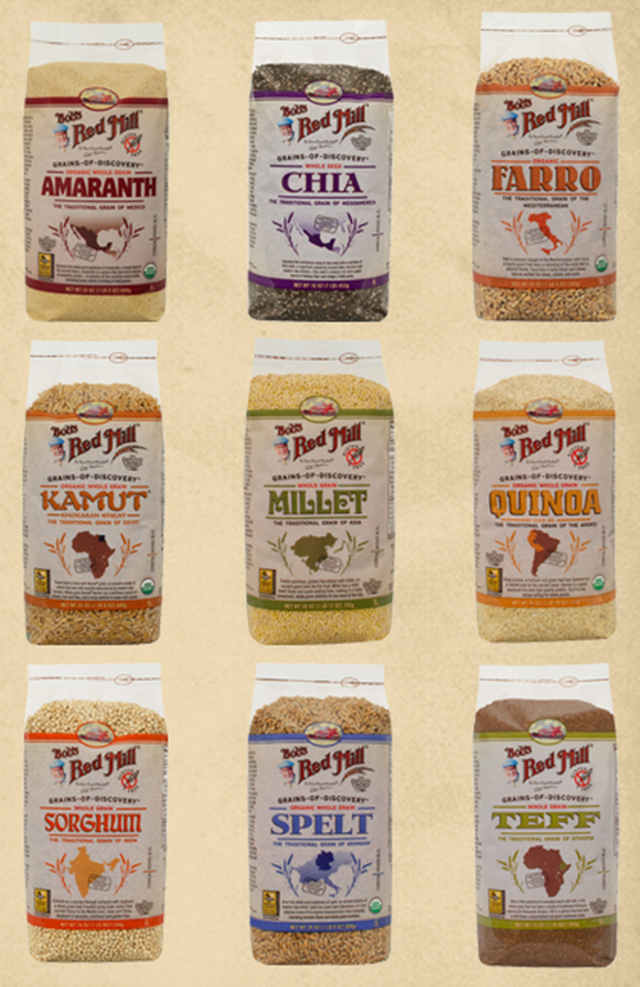New World Recipes for Ancient Grains

Sorghum, amaranth, and teff, oh my!
After observing the recent popularly of foods like quinoa and chia seed, Bob Moore (founder of Oregon-based Bob's Red Mill Natural Foods) traveled around the globe in pursuit of the planet's greatest grains. His global trek resulted in the new Grains of Discovery product line, a collection of nine heirloom grains first popularized by ancient civilizations.
Each grain has a rich history and can be used in a variety of healthy, delicious ways. Check out our recipe ideas below!
Kamut: This rich, nutty grain is also known as King Tut's wheat, the Prophet's grain, camel's tooth, and Khorasan wheat. Whatever you call it, the ancient grain is terrific for pilafs, stews, and salads.
- Kamut and Mixed Greens Pilaf
- Chipotle Carrot, Avocado and Kale Salad
- Chicken, Collard and Kamut Soup
Farro: This grain is thought to be the original ancestor of all wheat species. Farro was used as both nourishment and currency in ancient Rome, and is still highly popular with Italian chefs today.
- Farro and Sweet Dumpling Squash Tartlets
- Warm Farro Cereal with Coconut, Almonds and Cherries
- Black Bean, Corn, and Farro Vegetarian Burger
Spelt: This sweet, nutlike grain has proven popular in Germany since the Middle Ages. Iron-rich and easily digestible, spelt works well in soups and hot cereals.
- Spelt Berry Sushi Bowl with Roasted Cauliflower
- Spelt Salad with White Beans and Artichokes
- Spelt Berry and Tomato Stew
Sorghum: This chewy, hearty grain originated in ancient Africa and spread to India and China via the Silk Road. Sorghum can be eaten like popcorn, or incorporated into pilafs and salads.
- Sorghum Bowl with Black Beans, Amaranth and Avocado
- Beet, Carrot, and Sorghum Burgers
- Popped Sorghum
Quinoa: Perhaps the best known "grain" of the line, quinoa isn't a grain at all, but a gluten-free seed domesticated thousands of years ago in South America. A traditional staple food source from the pre-Columbian Andes, quinoa has a high protein content making it popular with present-day eaters as well.
Amaranth: Another "pseudo-grain" seed, high-magnesium Amaranth dates back over 8,000 years to the ancient Aztecs, who used it in religious rituals. Use it as a sub for polenta and ground in quick breads.
- Amaranth-Walnut Cookies with Brandy
- Oat and Amaranth-Crusted Ham and Cheese Quiche
- Amaranth Eggplant Burgers
Teff: The smallest grain in the world, Teff was first cultivated in Africa and has been a main ingredient in everything from bread to beer in Ethiopia for thousands of years. Its mild, nutty flavor and boost of calcium and iron—make it a prime pick for everything from baked goods to porridge.
- Sweet Potato, Chard, and Feta Tart with Teff Crust
- Ethiopian Injera Flatbread
- Teff Porridge with Dates and Maple Syrup
Chia: Though recently hailed as a superfood (and an ingredient in dairy-free "puddings"), chia was a staple in the diets of ancient Mayans and Aztecs, who extolled the seed's energy-boosting properties. Use it in sweet and savory dishes, as a crunch in salad, or as a replacement for flax seeds in baked goods.
Millet: First farmed 10,000 years ago, this famous grain appears in Marco Polo's journals, Herodotus' writings, and the Old Testament. Gluten-free and high in fiber, millet easily replaces rice in stir-fries and porridge.
